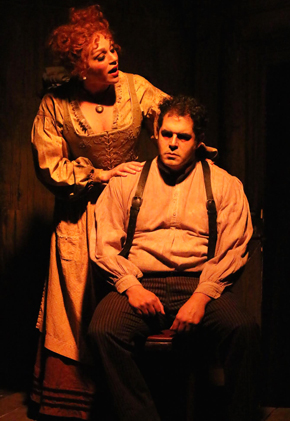
Stephen Sondheim's Sweeney Todd changed the face of the American musical when it premiered in 1979, its libretto proposing a plot premised on Victorian mass murder and cannibalism, recounted in a narrative employing nearly continuous music and minimal dialogue—a structure not unlike that of opera. The No Exit café's 1920s-vintage architecture made for acoustical difficulties even when the venerable Rogers Park coffee house was host solely to poets, folk musicians and chess tournaments. After Fred Anzevino installed his theater company within its crumbling confines, however, audibility became more of a concern—and not just because the Red line El train rolls by only a few yards from its front wall.
For this production, however, audiences finally acclimated to performers almost sitting in their laps must learn not to flinch at Edward Gorey-faces lurking over their shoulders. Why would Theo Ubique's creative artists escalate the intimacy of their space by staging a musical not merely in, but around and over its interior environment as well?
"We wanted to use the whole room, with actors appearing in unexpected places," says artistic director Anzevino, "Since the No Exit has an actual kitchen, it was logical to locate Mrs. Lovett's pie shop there. Scenically, the audience is sitting inside, and in front, of the shop."
When a production is configured along the lines of a performance corridor between two galleries of spectators, it's called "Alley Staging," but what do you call a play corraling its spectators with action on either side—"gutter staging" maybe? More important, what happens to the directional factors when vocalists trained to aim their voices at a fixed target must make themselves heard while revolving a full three-hundred-sixty degrees?
Anzevino is unperturbed. "I'm a stickler for vocal projection and articulation, anyway. We use limited amplification—chiefly choral microphones, suspended from the ceiling— for the far corners of the room, like the barber shop and Johanna's balcony. There's also one in the center of the room, so that Sweeney doesn't fade in and out when he turns in a complete circle for the song with the razors."
This doesn't mean that the show's personnel is merely a collection of "singing heads"—not when the lead roles of Sweeney and Mrs. Lovett are taken by baritone Philip Torre and mezzo-soprano Jacquelyne Jones—both well-versed in navigating huge auditoriums and recital halls, but now performing in a tiny room crowded with platforms and furniture. Both describe how, at the start of rehearsals, before anyone warbled a note, the cast paced through the entire play, guided only by the text.
"Fred [Anzevino] told everyone, 'sing to us, not at us'," Torre recalls, "At the Lyric, nothing can be small if you want the audience to register it. I think the role of Sweeney calls for classical technique, but I had to downshift it at times in order to not blast listeners out of the room. This also enabled me to explore the quieter end of Sondheim's score."
 Jones concurs, "You decide what moments need a punch and what ones can lay back. During the 'Worst Pies In London' song, I'm way back in the kitchen, so I 'throw' my voice in order to be heard, but then pull it in when the story told in the song needs a softer emotion." ("Mezzos don't always belt," Anzevino reminds us.)
Jones concurs, "You decide what moments need a punch and what ones can lay back. During the 'Worst Pies In London' song, I'm way back in the kitchen, so I 'throw' my voice in order to be heard, but then pull it in when the story told in the song needs a softer emotion." ("Mezzos don't always belt," Anzevino reminds us.)
"Balance is the real issue here," warns musical director Jeremy Ramey, "You have to constantly listen to your fellow cast members and to the band, so that the blend is always smooth and even."
What's the hardest part of performing in these narrow quarters? "Fred told us 'the No Exit demands honesty," replies Jones, "You can't lie to audiences in here."
And the easiest?
"There is no easy part!" Anzevino declares, adding with a smile, "Our job is to make it look easy!"
Sweeney Todd will run at the No Exit cafe through May 20.
Mary Shen Barnidge
Contributing Writer

 Follow Us On Twitter
Follow Us On Twitter